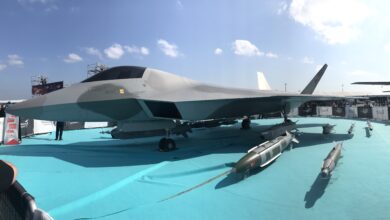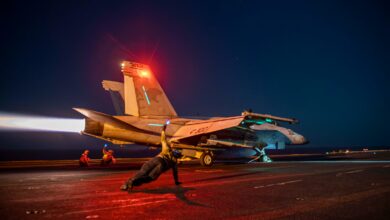
The United States and Turkey have agreed to a plan that could see the removal of the People’s Protection Units (YPG), part of the Syrian Democratic Forces fighting Islamic State, from Manbij in northern Syria, and replacement of the military stabilization force with one of their own choosing.
This is according to senior U.S. Department of State officials who spoke to reporters on Tuesday, June 5 on a background briefing call. Turkish officials have gone public in their interpretation of the roadmap agreed to by the two sides and announced on Monday.
The ‘roadmap’ endorsed by Turkish Foreign Minister Mevlut Cavusoglu and U.S. Secretary of State Mike Pompeo was the result of months of meetings since the visit by former U.S. Secretary of State Rex Tillerson to Ankara in February.
A joint Working Group on Syria was established as a result of those discussions which first met on March 8-9 in Washington.
Turkey’s state run Anadolu news agency on May 30 reported unnamed sources familiar with the meetings as saying that the Manbij plan was expected to be agreed on June 4.
According to Anadolu, the first item was that the YPG would leave Manbij, followed by a joint U.S.-Turkish military “inspection of Manbij.”
The third phase is to include the formation of both a local municipal council and a military council, “taking ethnic distribution of the population into consideration.”
Cavusoglu said at the time that the roadmap was based on a “concrete schedule” and the withdrawal of YPG forces “could be applied by the end of summer. Turkish and American soldiers will jointly supervise the withdrawal.”
But the U.S. officials on Tuesday’s press call said implementation of the roadmap would be dependent on conditions on the ground. Security in the city has been under Manbij Military Council control since November 2016, three months after the SDF ousted ISIS.
Manbij was captured from ISIS on August 12, 2016 by the U.S.-backed SDF after a 75-day battle, later named “Operation Martyr and Commander Faysal Abu Layla” after the commander’s death. Fighters from the YPG and Women’s Protection Units (YPJ) made up the bulk of those deployed in the operation, and the YPG said it handed its points of control west of the Euphrates river to Manbij Military Council as it had agreed ahead of the offensive. Turkey has long disputed this version of events, while the YPG said on Tuesday some of its forces had remained to advise MMC.

In a joint statement released after their meeting on Monday, Pompeo and Cavusoglu said they “considered the recommendations of the Turkey-U.S. Working Group on Syria pertaining to the future of our bilateral cooperation in Syria on issues of mutual interest, to include taking steps to ensure the security and stability in Manbij” and “endorsed a Road Map to this end and underlined their mutual commitment to its implementation, reflecting agreement to closely follow developments on the ground.”
The statement gave no details on the roadmap or the effect of the ministers’ endorsement. Speaking to reporters on Tuesday, a senior State Department official said the roadmap was a “broad political framework to fulfill the commitment the U.S. has made to move the YPG east of the Euphrates.”
In August 2016, U.S. Vice President Joe Biden called for Kurdish forces to leave Manbij, and ever since, Turkey’s insistent calls for the YPG to leave the city and move east of the Euphrates River have only grown more urgent.
Comments made by the two senior State Department officials on Tuesday demonstrate that the U.S. and Turkey are at odds, at least publicly, in their interpretation of the plan. Turkey is less than a month from a general election, while U.S. President Donald Trump is eager to get American forces out of Syria.
“The aim of this roadmap is the clearing of Manbij of all terror organizations and the permanent instatement of safety and stability,” Cavusoglu told a press conference in Washington on Monday. “In the first step, the determination of parameters for common plans for the removal of YPG-PYD from Manbij – you can also call it PKK – will be determined.”
Cavusoglu said Turkish and U.S. units would together monitor security in the city, and that the roadmap could be a blueprint for other areas in Syria.
“In the long term, this road map that will implemented in Manbij will be carried to other regions to implement security and stability in other regions in Syria. Meaning the cooperation will continue in other regions,” he said.
Cavusoglu said later that less than six months would be needed for the roadmap to be carried out.
“First Turkey and the U.S. will work on details of the roadmap to rid Manbij, Syria of the PYD/PKK terror group,” he said. “There is a specific date. This depends on the steps taken in the field.”
The mainly Kurdish YPG makes up the backbone of the SDF, but Turkey sees the group and its political arm, the Democratic Union Party (PYD), as terrorists inextricably linked to the outlawed Turkish Kurdistan Workers’ Party (PKK).
Earlier in the week, Turkey’s state news agency Anadolu reported that the roadmap included a timeline for YPG forces to leave Manbij within 30 days, joint U.S.-Turkey monitoring of Manbij after 45 days, and the ‘establishment’ of a local government after 60 days, followed by a military council to provide security.
Senior State Department officials suggested on Tuesday that the reports were inaccurate.
“We’ll have to let the Turks speak for themselves as to why they want to attach numbers, but there are elements of the framework that could be implemented quickly, and we already have started military discussions about some of the military-to-military aspect. There are other elements that will take considerably longer,” one official said.
“I don’t think that the timeframes that I’ve seen reported in the press reflect anything concrete.”
“We’re committed to doing this as quickly as we can but we can’t attach a specific timeframe to it,” a second official said.
Manbij Military Council
It is unclear how the current civilian and military council structures would be affected by the plan. One of the many things left uncertain is the future of Manbij Military Council.
“Manbij Military Council is significantly – significant majority Arab and local, and so obviously, critical elements of those structures we would anticipate would remain in place, and we’ll work this through with the Turks to make sure that they are comfortable with the long-term arrangements, as has been laid out in the roadmap,” one of the State Department officials said.
Manbij has “been a stable area and the agreement is to keep it that way,” the official said.
Although Manbij is rapidly becoming a more stable place, two U.S.-led Coalition personnel were killed in a March 29 car bomb explosion in the city that was later blamed on ISIS. Five others were injured.
Several senior MMC figures have also been the target of assassination. On March 23, MMC spokesperson Shervan Darwish was injured in an attack on the road between Manbij and Aleppo, and in November, a bomb exploded in a car belonging to Muhammad Abu Adel, the commander of Manbij Military Council. Although injured, Adel survived the attack. Both incidents were claimed or blamed on groups linked to Turkey.
More: Omar Alloush – murdered for building a shared future for Syria’s Arabs and Kurds?
“The agreement is YPG cadres that involved in governance will withdrawal and move and they can be replaced by locals who are mutually agreeable,” said a second State Department official on Tuesday.
“A key point though that the State Department left out is that the Manbij Military Council is local and it is majority Arab, but it is also an organization that supports and promotes Ocalanism. In this way the Manbij Military Council is a bit of a nightmare for Turkey because it is the model for how Syrian Arabs can honestly and authentically support Ocalan’s ideas and implement them on the ground,” said Nicholas A. Heras, Middle East Security Fellow at the Center for a New American Security.
“The fact that the Manbij Military Council will have a role in Manbij moving forward is a major concession that the Turks seem to be making. And it might just be the bellwether that there is actually a mood on the Turkish side to get a deal done.”

A source familiar with U.S. and Coalition operations in Syria told The Defense Post that the U.S. had sought a deal with Turkey that would allow two key components of the MMC to remain in Manbij.
“In the first phase of negotiations the Americans offered to Turkey that only the Turkish forces could enter the city and all of the Kurdish elements would withdrawal from the city,” with the MMC’s Jund al-Harmeen and Kataib Shams ash-Shamal – the famed Northern Sun Battalion – remaining, the source said.
“These two factions are part of Manbij Military Council. The Turks rejected this offer without any negotiations, and both parties started to increase the situation from their own sides.”
The source said the Americans and French began “high-ranking visits” to Manbij and increasing their forces inside the city, while signalling they were ready to respond to an assault. “The Turks increased the situation from their side by pushing on the ground cells for making explosions, targeting SDF or U.S. patrols,” while pushing for demonstrations against the MMC.
“So after this situation they have a deal at the end of the day saying that the Turkish forces will enter the city,” the source said.
Heras said the ‘canary in the coal mine’ for northern Syria is not what the YPG does, but what the MMC does.
“So long as the Manbij Military Council remains on the scene in Manbij, the situation will continue at the status quo,” he added.
French forces in Manbij
“No third country will have a say in Turkey-U.S. deal whether it is France, United Kingdom or Belgium,” Cavusoglu said on Monday.
He said the deal was a “bilateral roadmap,” not “an international agreement.”
The French Armed Forces are involved in Iraq and Syria with Operation Chammal. French President Emmanuel Macron has claimed he convinced Trump to stay longer and send additional troops to Manbij, although the White House insists Trump still favors a timely withdrawal.
Macron’s has office said that France is not planning a new military operation in northern Syria “outside the international coalition” against ISIS.
In March, a Syrian delegation said after a meeting with Macron that France was “very quickly” to send troops to Manbij in coordination with the U.S. Days later, Kurdistan24 reported that French troops were operating on the ground in Manbij and Raqqa.
“French support in Manbij was very essential and very strong and I think it was answer to threats made by Turkey against Manbij, and I think France and the U.S. are doing great job to defend Manbij and all of northern Syria as its part of the Coalition work to protect the areas liberated from ISIS,” SDF spokesperson Kino Gabriel told The Defense Post at the time.

Coalition spokesperson Colonel Thomas Veale said on Tuesday that U.S. troops are still on the ground in Manbij, but would not speculate on the future.
There is “no immediate plan to change the footprint,” Veale said when asked about the impact of U.S. and French special forces in Manbij.
“As we have consistently done with all of our efforts in Syria, our key Coalition partners were briefed on the roadmap and situation regarding Manbij,” a State Department spokesperson told The Defense Post.
A French diplomatic source told The Defense Post that France was informed by both the U.S. and Turkey about the discussions and the roadmap.
“We hope that this agreement will contribute to stability in the region. In this respect, France will pay close attention to the model of governance established. It must be pluralistic, representative and accepted by the local populations. This is our objective in all towns that have been liberated from Daesh,” the source said.
“The stabilization of the territories liberated from Daesh is essential in order to permanently eradicate the terrorist organization, in keeping with the ongoing military campaign. This goal requires the Coalition’s long-term commitment.”
Both State Department officials stressed that there was no plan for a long-term U.S. and Turkish occupation of Manbij.
“This will not be U.S. forces stabilizing the streets in the city of Manbij. That’s not what’s envisioned here. We want locally rooted forces to continue to provide the stability and security in Manbij,” one official said.
“The idea behind this is not for the U.S. or Turkey to take over Manbij. The idea is for the people of Manbij to reassert their leadership over both governance and security structures there,” said the other.
Future of SDF operations
The SDF has its sights on Islamic State, as it has done since its formation. On Sunday it announced a new phase of Jazeera Storm, which the Coalition calls Operation Roundup, the operation to clear remaining ISIS fighters from Deir Ezzor in northern Syria.
“ISIS has several thousand fighters in the area and all of them are surrounded, and they managed to reorganize lately during the time when the operation was stopped, so we know it will be hard. We are hoping for complete defeat of ISIS, and for that we will take time needed to move through the operation and to completely finish ISIS in that area,” the SDF’s Gabriel told The Defense Post last month.
Shortly ahead of the State Department briefing, Pompeo released a statement in support of the ongoing SDF operation in Dashisha.
“The fighting over the days ahead will be extremely difficult,” Pompeo said. “We have full confidence in our partners, the Syrian Democratic Forces, and we are proud to work with them to rid Syria from the scourge of ISIS and help build a better future for all Syrians.”
The YPG may have itself undercut any moves by the Americans or Turks. On Tuesday, the general command announced that the remaining YPG advisors will leave Manbij, where they are supporting the MMC.

“Their work continued from then [November 16, 2016] until now, and now more than two years later from their ongoing work, and the self-sufficiency of the Manbij Military Council in the areas of training, the General Command of People’s Protection Units (YPG) decided to withdraw its military advisers from Manbij,” the YPG said.
The announcement came two years to the day after the death of Abu Layla, the SDF commander and leader of Shams ash-Shamal who died on June 5, 2016 after being shot in the head two days earlier by an ISIS sniper.
“I do believe that the YPG was making a point with the announcement on the anniversary of Abu Layla’s death,” CNAS’s Heras said. “The YPG sent the message that it was thanks to Abu Layla that the Manbij Military Council was a success, and that he built a legacy for his city that is standing on its own and can endure.”
US gave guarantees to protect Manbij after Turkey deal, MMC spokesperson says
Fergus Kelly contributed reporting











